
Posted on 07/22/2013 5:35:45 AM PDT by Homer_J_Simpson


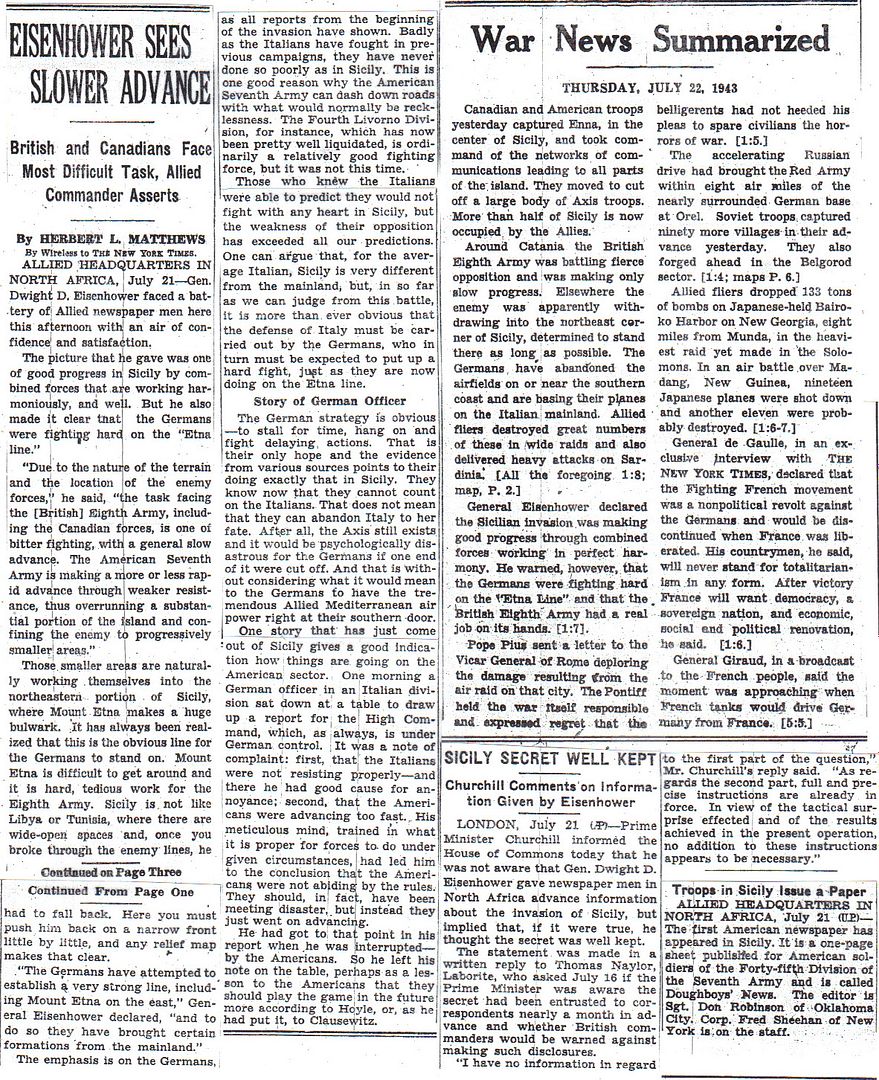


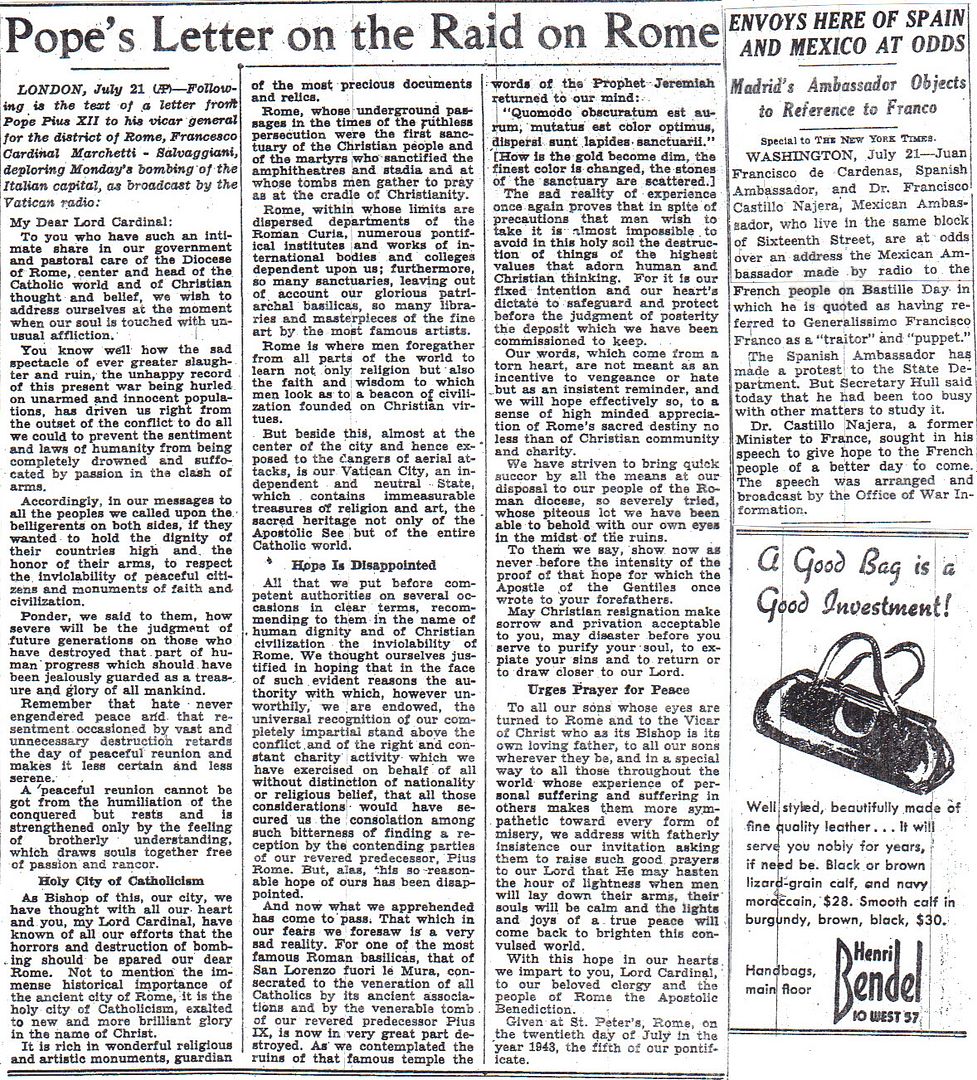
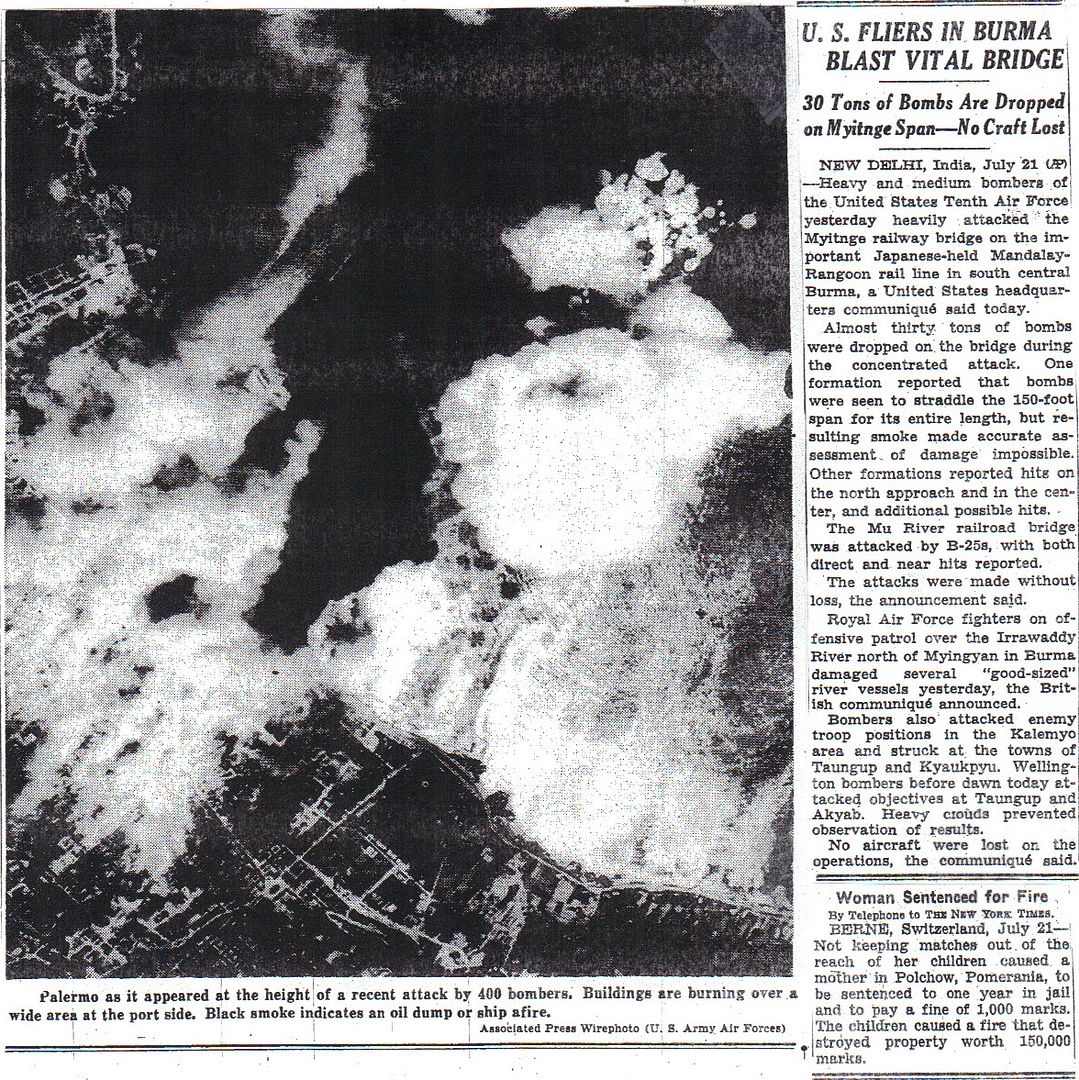
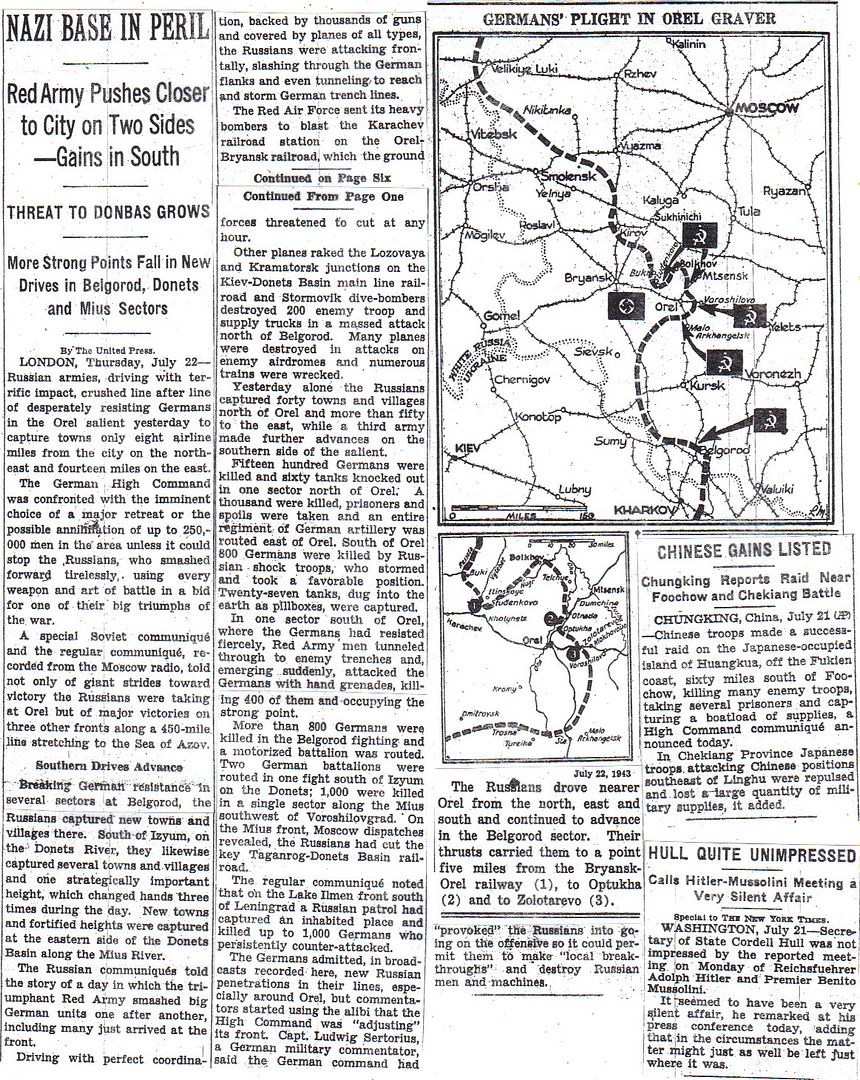
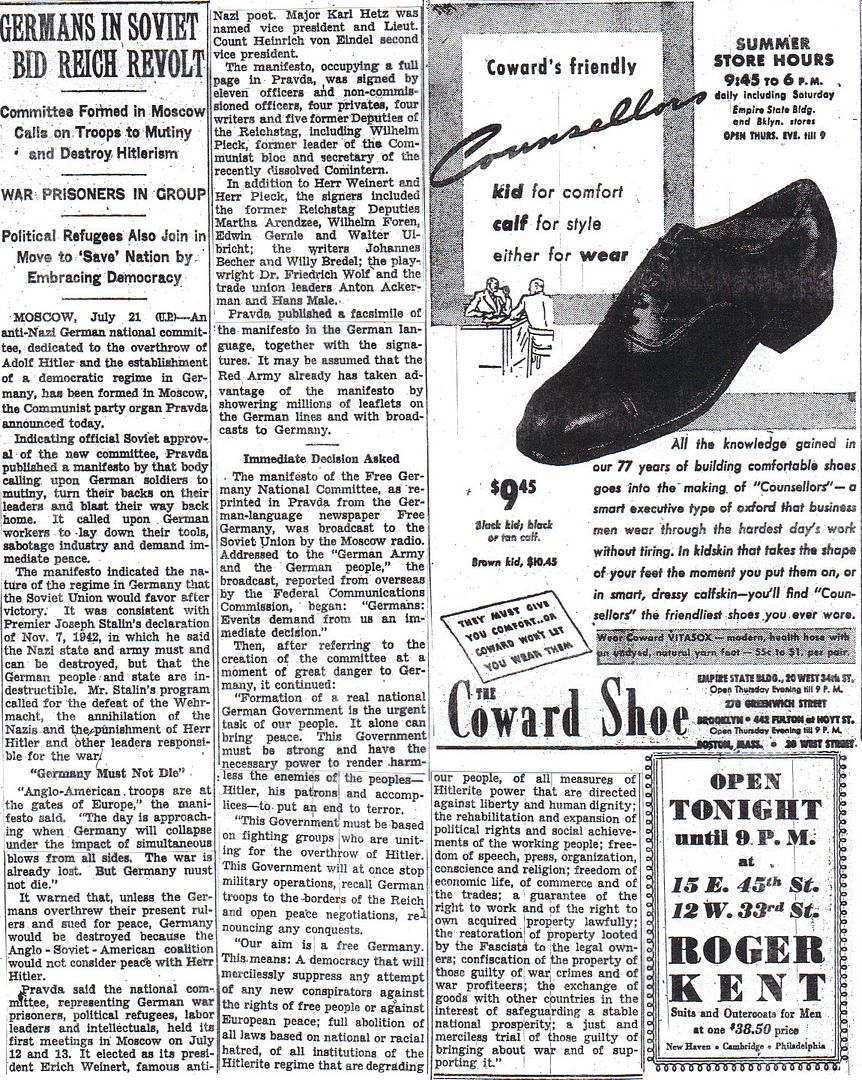
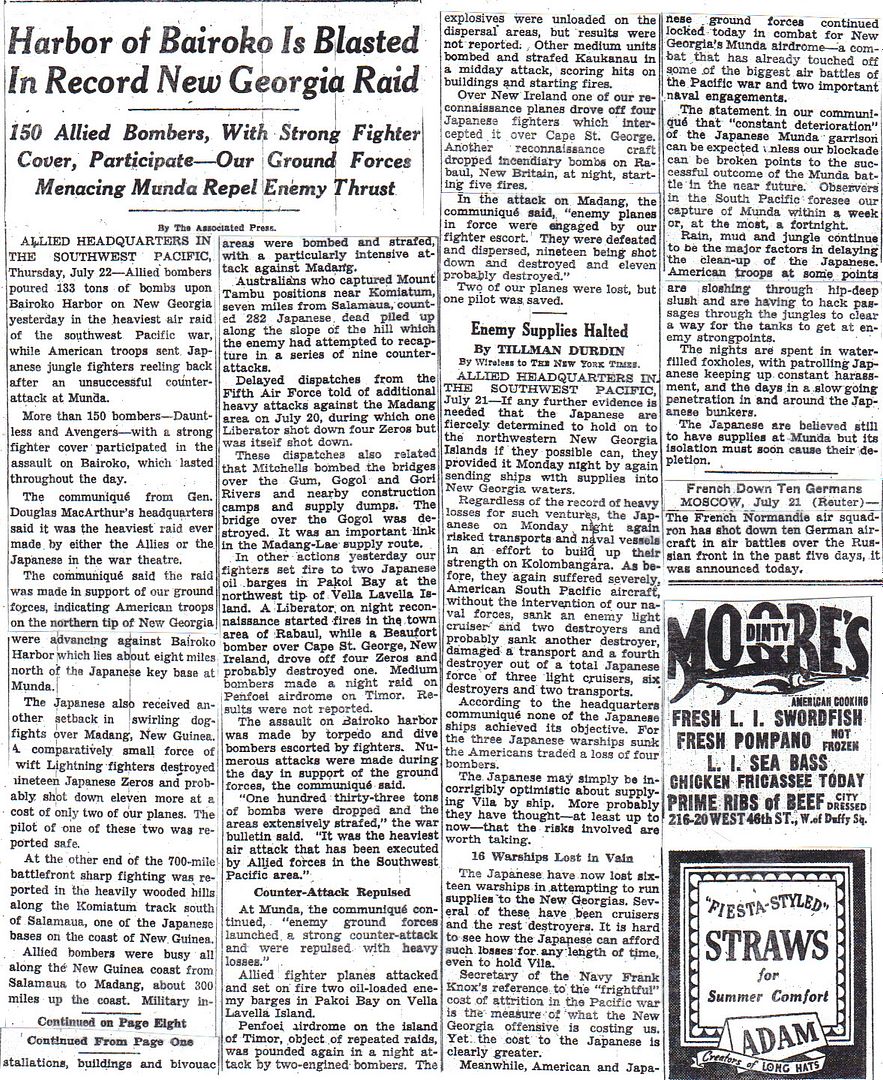

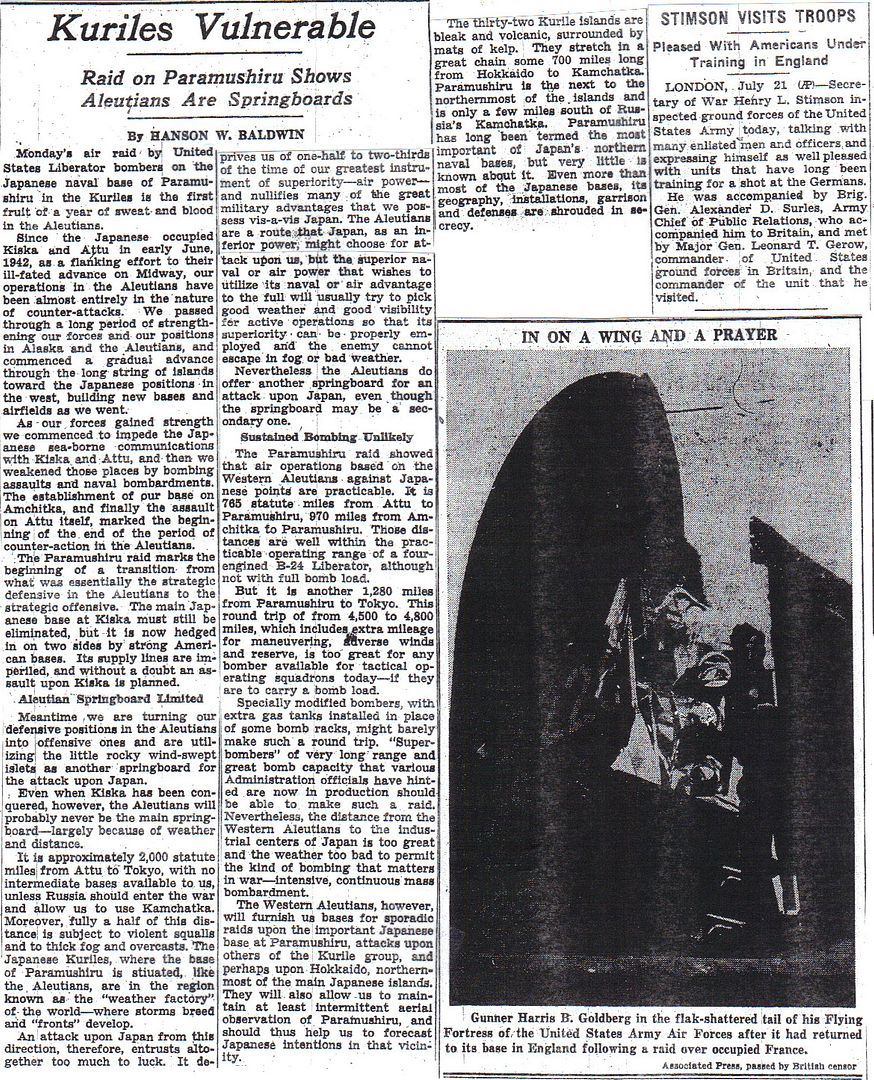
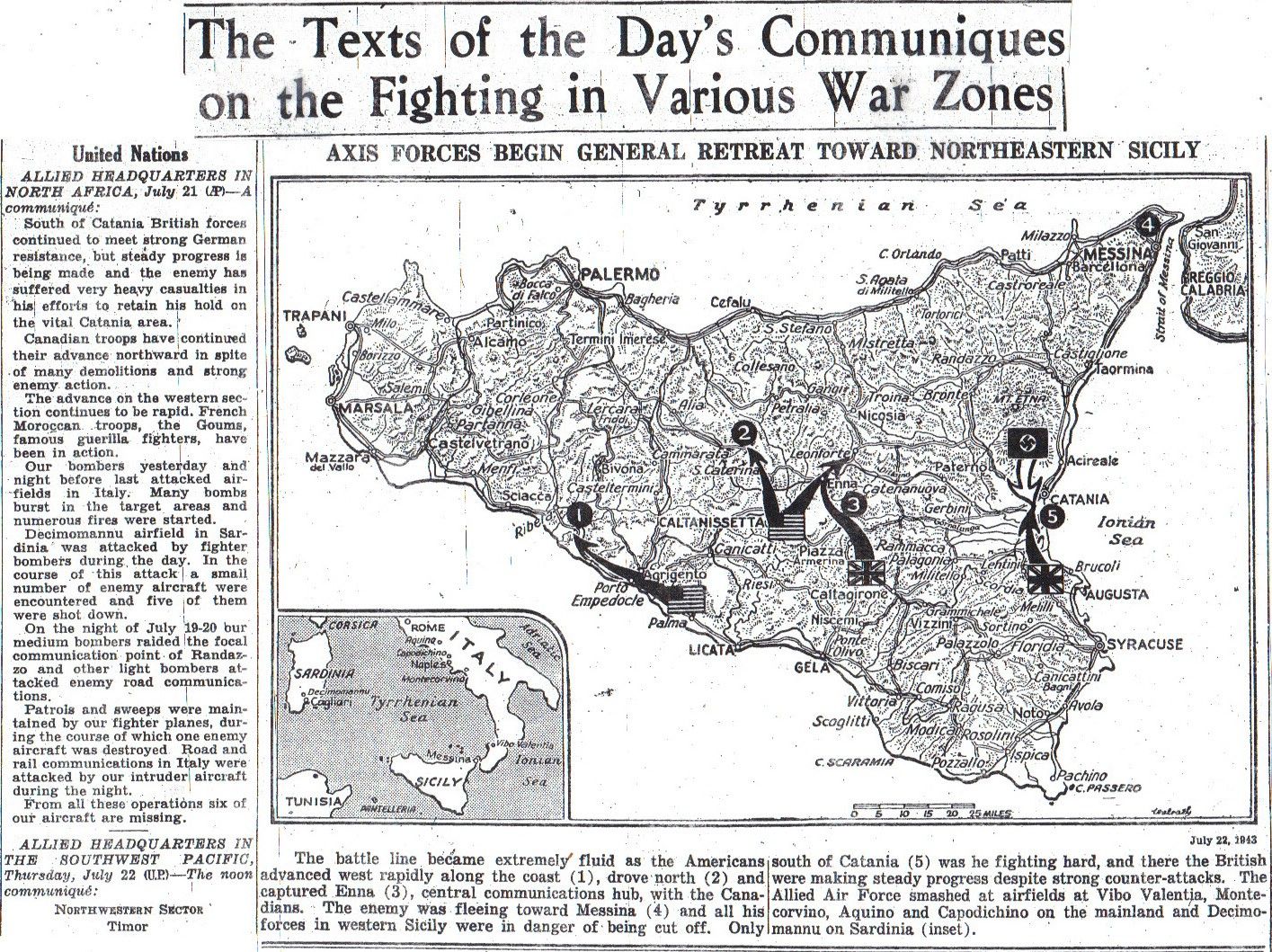
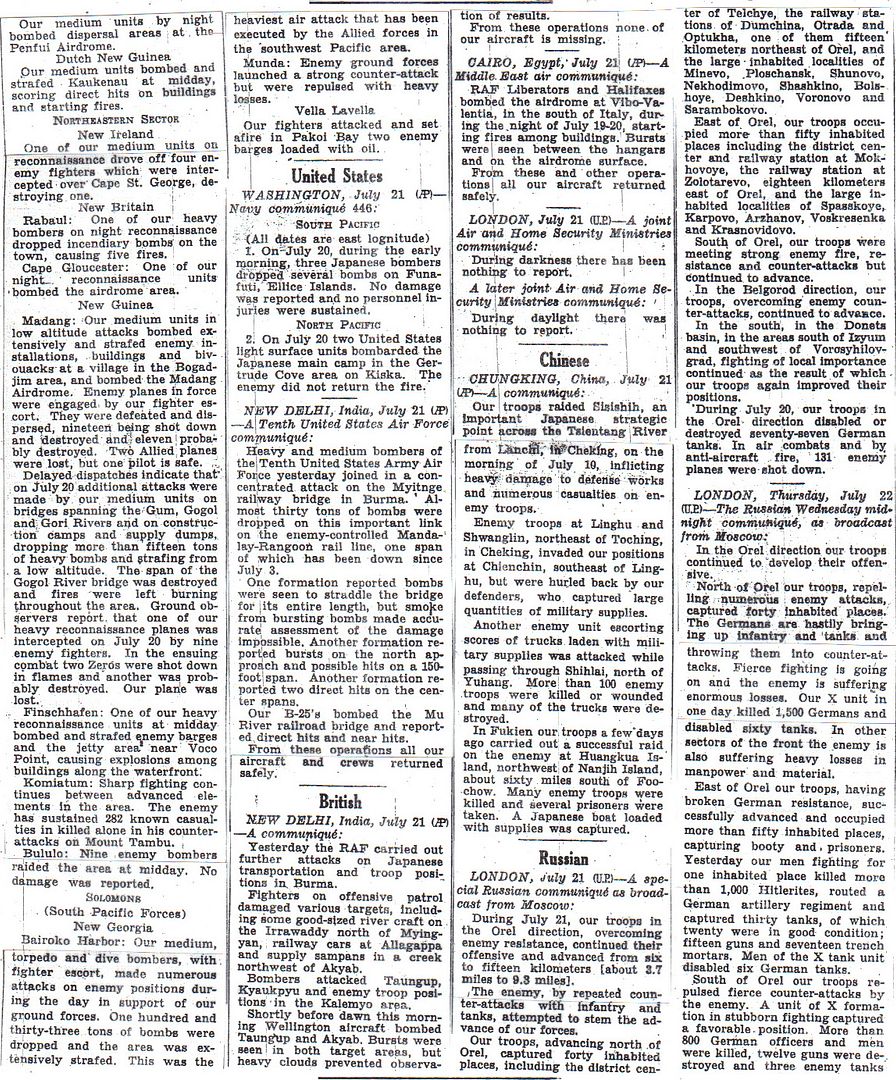
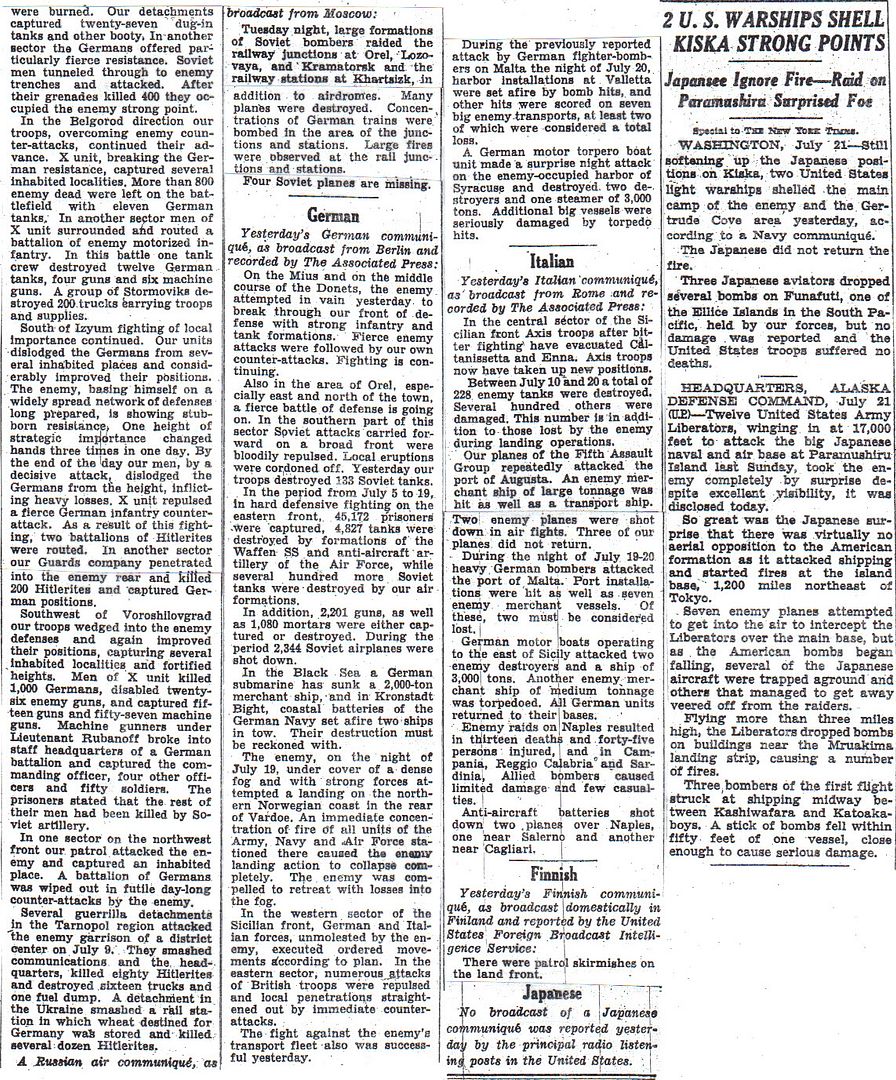

Winston S. Churchill, Closing the Ring
http://www.onwar.com/chrono/1943/jul1943/f22jul43.htm
US troops take Palermo, Axis forces escape
Thursday, July 22, 1943 www.onwar.com
German soldiers fighting on Sicily [photo at link]
In Sicily... American forces enter Palermo and isolate 50,000 Italian troops in the west of the island. The Axis mobile forces, including most of the German forces, escape to the northeast corner of the island.
In the Aleutian Islands... US naval forces (2 battleships and 4 cruisers as well as lighter units) bombard Japanese held Kiska Island.
http://www.etherit.co.uk/month/thismonth/22.htm
July 22nd, 1943 (THURSDAY)
UNITED KINGDOM: The results of the first phase of the Combined Bomber Offensive (CBO) are good according to a report of the British Joint Intelligence Committee. The report maintains the CBO has caused Germany to adopt a defensive air strategy resulting in more than half its fighter strength being employed on the Western Front at the expense of the Eastern and Mediterranean Fronts as well as causing considerable damage to transportation, the synthetic rubber industry, and the fuel, iron, and coal industries of the Ruhr.
Destroyer HMS Ursa launched .
Minesweeper HMS Frolic launched.
Corvette HMS Allington Castle laid down.
GERMANY:
U-989 commissioned
U-349, U-995 launched.
ITALY: US forces enter Palermo on Sicily. This cuts off 50,000 Italian troops on the west side of the island. It does not stop the mobile German troops from escaping.
As advance units of Lt-Gen Patton’s Seventh Army swept down from the mountains and raced along the coastal road towards this city today, the Axis garrison fled in complete disorder.
Patton’s advance across Sicily has been spectacular, with opposition weakening daily as the American strength grew. Now the race for Messina, in the east of the island, can really start.
The 1st Infantry Division continues north, taking Bompietro.
The British Eighth Army, fighting in the shadow of Mount Etna, is facing a much more difficult task against the German paratroopers whose 88mm anti-tank guns are again proving a formidable weapon - particularly in hilly terrain.
Canadians of Lord Tweedsmuir’s Hastings and Prince Edwards Regiment have managed to take the hill town of Assoro using a ruse employed by General Wolfe in his capture of Quebec almost 200 years ago. The town stands on a precipitous cliff face, and it was this that the Canadian scaled “in 40 sweating, tearing minutes”, surprising the German defenders completely. The Canadians began to advance on the main objective, the town of Leonforte, which was cleared today after street fighting which lasted all night.
In the air, Northwest African Tactical Air Force (NATAF) light bombers hit Randazzo, the railroad at Falcone, the road west of Marina, Adrano, Paterno, Troina, and Misterbianco.
During the night of 21/22 July, Northwest African Strategic Air Force (NASAF) Wellingtons bomb Capodichino Airfield and Salerno marshalling yard. During the day, 100+ B-17s bomb the Battipaglia marshalling yard and Foggia; B-26s hit a Salerno bridge and marshalling yard; and fighters fly a sweep over Maddalena Island, strafing factories, trucks, and small vessels.
SOLOMON ISLANDS: During the afternoon, 20+ B-17s and B-24s, 12 Navy PB4Y-1 Liberators, 18 SBD Dauntlesses and 18 TBF Avengers escorted by 134 Allied fighter aircraft attack shipping in the area off Buin, Bougainville Island. A sea-plane carrier is sunk, and damaging hits are claimed on several other vessels. Navy F4F Wildcat pilots shoot down 5 A6M “Zekes.”
A US reconnaissance party lands in Vella Lavella.
PACIFIC OCEAN: USS Sculpin (SS-191) sinks the seaplane carrier HIJMS Nisshin east of Kokoda Island off New Guinea at position 3.47S 151.36E. (Jack McKillop and Massmiliano Stola)
TERRITORY OF ALASKA: ALEUTIAN ISLANDS: The USN’s Task Groups 16.1 and 16.2, under Rear Admiral Robert C. Griffin, bombard Kiska Island.
TG 16.1, composed of the heavy cruisers USS Louisville (CA-28), USS San Francisco (CA-38) and USS Wichita (CA-45), the light cruiser USS Santa Fe (CL-60) and five destroyers, fires 1,719 rounds for 21 minutes at the Main Camp and Little Kiska Island.
TG 16.2, composed of the battleships USS Mississippi (BB-41) and USS New Mexico (BB-40), the heavy cruiser USS Portland (CA-33) and four destroyers, fires 1,084 rounds for 18 minutes on North and South Head, Sunrise Hill and the Submarine Base.
The Japanese return fire but it is ineffective. IJN submarines are reported but they turn out to be two porpoises and three whales.
The USAAF’s Eleventh Air Force dispatches 26 B-25 Mitchells, 17 B-24s, 13 P-40s, and 20 P-38 Lightnings hit North Head, Main Camp, and the submarine base at Kiska Island, as well as coastal defenses and Anti-Aircraft guns at both Kiska and Little Kiska Islands, starting numerous fires.
Intense and heavy AA fire downs one B-25 (crew saved) and damages 18 aircraft of which another B-25 crashes at base.
One B-25 photographs the southern and western Kiska Island shores while a B-24 flies radar reconnaissance over Kiska Island.
CANADA: HMC ML 125 commissioned.
Minesweeper HMCS Middlesex launched Port Arthur, Ontario.
Henry Asbjorn Larsen 1899-1964 leaves Halifax on the RCMP patrol ship St. Roch to return to Vancouver via Northwest Passage; completes trip 86 days later.
U.S.A.:
Escort carrier USS Bolinas commissioned.
Destroyer escort USS Canfield commissioned.
Destroyer escorts USS Eichenberger and James E Craig launched.
ATLANTIC OCEAN: At 0921, the unescorted Cherry Valley was hit by two torpedoes from U-66, while steering a zigzagging course at 15.5 knots. The torpedoes struck the starboard side between the #6 and #7 tanks. The explosions ripped open the #5, #6, #7 and #8 starboard and centre tanks. The engines and steering gear were not damaged and the tanker tried to escape at a reduced speed of 13 knots. U-66 followed the tanker and fired a spread of three torpedoes at 1130; one was seen passing ahead and one other astern. The U-boat then surfaced to stop the vessel with gunfire. The tanker was armed with one 5in, one 3in and eight 20mm and fired back, forcing the U-boat to break off the attack. The list to port was adjusted by emptying the #1 starboard tank and the Cherry Valley successfully escaped. She arrived at San Juan, Puerto Rico, under her own power, escorted into port by the HNLMS Jan van Brakel on 24 July. There were no casualties among the eleven officers, 40 crewmen and 28 armed guards. Eventually she was repaired and returned to service.
At 1510, U-81 torpedoed the Empire Moon, which was sailing in an unidentified convoy, escorted by HMS Stroma. The ship reached port safely.
War Mobilization Director James F. Byrnes, looks like a rising star in the Democratic Party.
Looks like things are heating up on Kiska in the Aleutians. There could be a bloody battle there when the Marines land.
The “Free Germany Committee” will gain some important spokepersons in the near future, notably Gen. Seydlitz and Field Marshal Paulus, both captured at Stalingrad.
It is not the last time we will hear the names of Ulbricht and Pieck. They are just Stalin’s sock puppets now and will be when the war ends. The war will be over for 10 years and still hundreds of thousands of their fellow countrymen, captured as POWs, will languish in Soviet labor camps. These communist scum won’t lift a finger to aid them or secure their release. It will take the death of Joseph Stalin and a state visit to Moscow by West German Chancellor Konrad Adenauer in 1955 to finally accomplish this. The price will be recognition of East Germany, the split of the nation will seem permanent, but it was the price to pay to “bring the boys back home.”
No thanks to Walter Ulbricht or Wilhelm Pieck.
IIRC, my US Army maps of Europe in the 1970's still reflected the pre-war boundaries of Germany.
Including Pomerania, East Prussia and Silesia?
They said "Do Widzenia" to Germany.
Yes. The actual boundaries were on the maps, of course, but the outlines of the pre-WWII borders were still there, including the Baltics. I never saw that on our tactical maps, but it was on the official map of Europe, or at least that part of Europe (it was a while ago). It made quite an impression on me at the time, because unification of Germany or independence for the Baltics seemed like such a lost cause. I might still have that in a footlocker, I’ll take a look tonight . . .
I guess technically, since for many years there was not an official treaty ending WW2 in respect to Germany, there was no internationally legal basis to recognize the Oder-Neisse border between Germany and Poland. It was a “provisional” border set at Potsdam, with an understanding that the official border would be ratified later. So, technically, the map was correct.
The Treaties of Paris in 1947 resolved territorial issues relating to all European Axis powers except Germany. Per Wikipedia, the final treaty was “Treaty on the Final Settlement with Respect to Germany.” What a great name for a peace treaty. It was signed in Moscow, USSR, on 12 September 1990, and it paved the way for German reunification on 3 October 1990. It also formally established the Oder-Niesse border between Poland and Germany.
That must have been the rationale since the Sov’s would not agree to a WWII peace treaty with Germany that did anything other than make permanent East Germany’s status. Good thing Obama wasn’t around in those days to surrender that to Russia.
Disclaimer: Opinions posted on Free Republic are those of the individual posters and do not necessarily represent the opinion of Free Republic or its management. All materials posted herein are protected by copyright law and the exemption for fair use of copyrighted works.